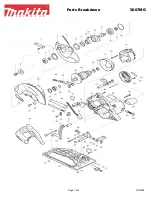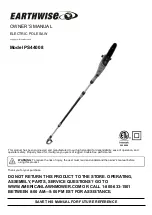
3
12
Pocket Cutting
Pocket cutting is used to start a cut in a
piece of wood from other than the edge. Use
extreme caution when beginning a
pocket cut.
1.
(SEE FIGURE 12)
Tilt the saw forward so the
front of the base is firmly in contact with
the wood.
2. Using the handle (1) on the lower blade
guard (2), pull back the guard to expose the
blade. Lower the saw until the teeth of the
saw almost touch the wood. Release the
lower blade guard.
3. While holding the saw with both hands, turn
the saw on and allow it to come to
full speed.
4. While keeping the front of the base in firm
contact with the work piece, slowly tilt the
saw until the blade contacts the wood.
Continue tilting the saw until the saw base
rest flat on the wood and the saw blade
spins freely.
5. Allow the saw blade to come to a complete
stop before removing saw from pocket.
Using the Rip Fence
1.
(SEE FIGURE 13)
Slide rip fence into slots
on saw base. Adjust to the desired position
shown on rip scale and secure with adjust-
ment knob.
2. Follow cutting procedure as outlined in
"General Cutting" section of this manual.
Cutting Sheet Goods
WARNING:
Cutting sheet goods is prone to
kickback. You must read, understand and
follow "Causes and Operator Prevention of
Kickback" section of this manual.
1.
(SEE FIGURE 14)
Position long workpieces
and sheet goods so that both the cut and
large cut-off pieces are supported.
2. Provide a secondary support means near
the blade to prevent sagging that could
pinch the blade.
3. Adjust depth of cut so that workpiece is cut
but not the underlying supports.
4. Follow cutting procedure as outlined in
"General Cutting" section of this manual.
DANGER:
1.
Keep hands away from cutting area and the blade. Keep your second hand on auxiliary
handle or motor housing.
If both hands are holding the saw, they cannot be cut by the blade.
2.
Do not reach underneath the workpiece.
The guard cannot protect you from the blade below
the workpiece.
3.
Adjust the cutting depth to the thickness of the workpiece.
Less than a full tooth of the
blade teeth should be visible below workpiece.
4.
Never hold piece being cut in your hand or across your leg. Secure the workpiece to a
stable platform.
It is important to support the work properly to minimize body exposure, blade
binding or loss of control.
5.
Hold power tool by insulated gripping surfaces when performing an operation where the
cutting tool may contact hidden wiring or its own cord.
Contact with "live" wire will also
make exposed metal parts of the power tool "live" and shock the operator.
6.
When ripping always use rip fence or straight edge guide.
This improves the accuracy of the
cut and reduces the chance of blade binding.
7.
Always use blades with correct size and shape (diamond verses round) of arbor holes.
Blades that do not match the mounting hardware of the saw will run eccentrically, causing
loss of control.
8.
Never use damaged or incorrect blade washer or bolt.
The blade washer and bold were
specially designed for your saw, for optimum performance and safety of operation.
WARNING:
1.
Check lower guard for proper closing before each use. Do not operate the saw if lower
guard does not move freely and close instantly. Never clamp or tie the lower guard into the
open position.
If saw is accidentally dropped, lower guard may be bent. Raise the lower
guard with the retracting handle and make sure it moves freely and does not touch the blade
or any other part, in all angles and depths of cut.
2.
Check the operation of the lower guard spring. If the guard and the spring are not
operating properly, they must be serviced before use.
Lower guard may operate sluggishly
due to damaged parts, gummy deposits, or a build-up of debris.
3.
Lower guard should be retracted manually only for special cuts such as "plunge cuts" and
"compound cuts." Raise lower guard by retracting handle and as soon as blade enters the
material, the lower guard must be released.
For all other sawing, the lower guard should
operate automatically.
4.
Always observe that the lower guard is covering the blade before placing saw down on
bench or floor.
An unprotected, coasting blade will cause the saw to walk backwards, cutting
whatever is in its path. Be aware of the time it takes for the blade to stop after switch
is released.
SPECIFIC SAFETY RULES
Figure 12
Figure 14
Figure 13
1
2


























